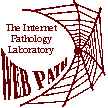Clinical History:
- A 15-year-old previously healthy girl is sent home from summer camp because she has exhibited weakness, lassitude, and complaint of a sore throat for the past 3 days. On physical examination she has pharyngeal erythema and enlarged tonsils without overlying exudate. She has several enlarged and slightly tender lymph nodes in her neck. She has a palpable spleen and a tender palpable liver edge. Laboratory studies include a CBC showing Hgb 14.9 g/dl, Hct 44.9%, MCV 92 fL, platelet count 282,100/microliter, and WBC count 12,500/microliter. Her peripheral blood smear is shown.
- What is the predominant white blood cell type?
The predominant cell is a lymphocyte. There is an absolute lymphocytosis with many atypical lymphocytes (large lymphs with abundant light to deep blue cytoplasm, round to ovoid nuclei with occasional indentation by other cells, and nucleoli).
- What is your diagnosis in this case?
The diagnosis is infectious mononucleosis, due to Epstein-Barr virus (EBV) infection.
- What is the differential diagnosis?
The differential diagnosis includes various viral infections including hepatitis and cytomegalovirus. The signs and symptoms seen with infectious mononucleiosis are similar to those for acute HIV infection. This process should not be confused with leukemia.
- What other laboratory test may be helpful in arriving at a specific diagnosis?
A serologic test for infectious mononucleosis would confirm the diagnosis in most cases.
|
|



